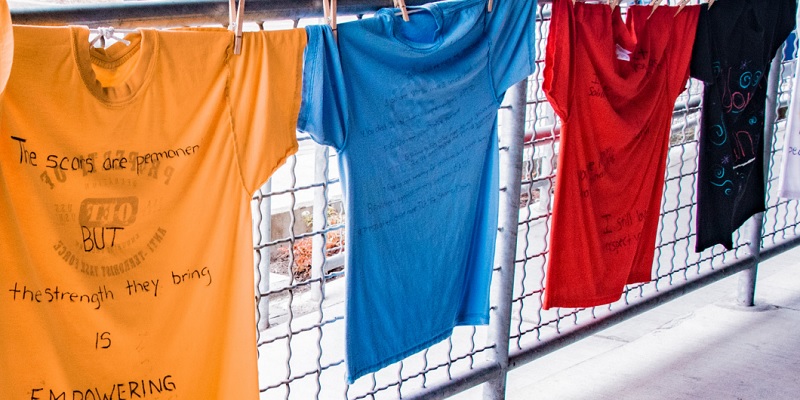Annual Clothesline Project expands on UWT campus
April 2–10, T-shirts were displayed along the Tioga sky bridge and hung from the railing that spans from the Joy to the Garretson Woodruff & Pratt building as part of the annual Clothesline Project.
UW Tacoma’s Clothesline Project is run by the UWT Criminal Justice League and UWT Student Social Work Organization to help spread awareness about sexual assault and other forms of violence. The project is similar to other clothesline projects that happen worldwide to spread awareness and educate communities. As part of the project, T-shirts were decorated either by those who have experienced sexual assault or violence themselves, or in honor of someone who has.
Tina Goelz, president of the Student Social Work Organization, describes the Clothesline Project as a visual display that showcases underlying issues.
“The Clothesline Project is like a visual art display,” Goelz said. “We hung up shirts. They are all different colors. Every color such as red or black or green has a different meaning.”
The following are what each color t-shirt signifies:
- white represents women who have died because of violence
- yellow and beige represents those who have been battered or assaulted
- red, pink, and orange are for survivors of rape and sexual assault
- blue and green t-shirts represent survivors of incest and sexual abuse
- purple and lavender represents those who are attacked because of their sexual orientation
- black is for people attacked for political reasons
According to Oscar Trinidad, president of the Criminal Justice League, the shirts were intended to speak for themselves.
“I always gets questions of what can I put on my shirt,” Trinidad said. “[I always reply:] ‘Anything you want.’ I’m not here to pass judgment. We bring the supplies and let people do what they wish with their shirts. There’s a lot of very powerful messages out there.”
Trinidad said that allowing participants to have the freedom to express themselves can also allow for healing.
“The idea behind [the Clothesline Project] is to spread awareness,” Trinidad said. “Also it is a form of art therapy. If it is therapeutic for them and helps them deal with violence that they themselves have had, or a friend or a loved one has had, it can help a great deal.”
After several years of the Clothesline Project taking place on campus, some changes were made to this year’s project. This year, the project doubled in the amount of days that the shirts were displayed and new shirts were added throughout the eight day span.
“We started off different this year,” Trinidad said. “We started with shirts we had from previous seasons and have added more as they have been decorated.”
Considerations by the organizers inspired more changes that took place. They took into account the exposure of the shirts to the weather and how they were being presented to the public. They wanted to be able to leave the shirts up overnight, protect them from rain, and meet the needs and concerns of students and those participating in the project. This prompted the move from last year’s location of the Prairie Line Trail and Tioga Bridge to their current locations.
“Students come up with new suggestions,” Goelz said. “Last year we had the Clothesline Project on the Prairie Line trail. This year we decided to make it a little more anonymous and not as visible because of the vulnerability of victims and survivors.”
Trinidad sees the change in location as a move that has not taken away from the mission of the project.
“I like to think that the adoption of having it run down the rails didn’t take away from the message at all. It’s not as pure as a true clothesline, but it still conveys the message,” Trinidad said. “The fact that it is more visible — students can walk right out of class and those shirts are there. They really stare back at you and make a statement. That’s the purpose: to spread awareness. I think we have accomplished that with adopting this new way of exposure.”
To conclude the Clothesline Project, a series of workshops, a panel discussion and a Take Back the Night march were held April 10.
It was events like the Clothesline Project that inspired Trinidad to become president of the Criminal Justice League and continue the tradition.
“Through the [former] officers and helping out last year, I just said I didn’t want to see the club die. I didn’t [want to] see these events that we have not happen,” Trinidad said. “We just see clubs that pop up every year fade away.”
Trinidad encourages students to contact the Criminal Justice League and Student Social Work Club to not only get involved, but to help ensure the continuation of projects like the Clothesline Project since they are student run. He explained that if neither of these organizations existed, then projects such as the Clothesline Project and the workshops affiliated with it would never happen.
“After this event, we are going to be recruiting officers for next year,” Trinidad said. “If you feel empowered, join the club, become an officer and run it. Take the feeling you get from this week and use it.”
For those seeking assistance for sexual assault or violence, there are resources available for support. Goelz provided recommendations for support on campus and in the surrounding Tacoma area.
“I always like to refer people to the Counseling Center and Student Advocacy and Support,” Goelz said. “There is also the YWCA of Tacoma, the Crystal Judson Family Justice Center and the Women’s Support Shelter.”
For help finding resources, contact UW SafeCampus at 253-692-SAFE (253-692-7233)
or reference the emergency guide from UW Tacoma Safety and Security at
tacoma.uw.edu/node/39909




